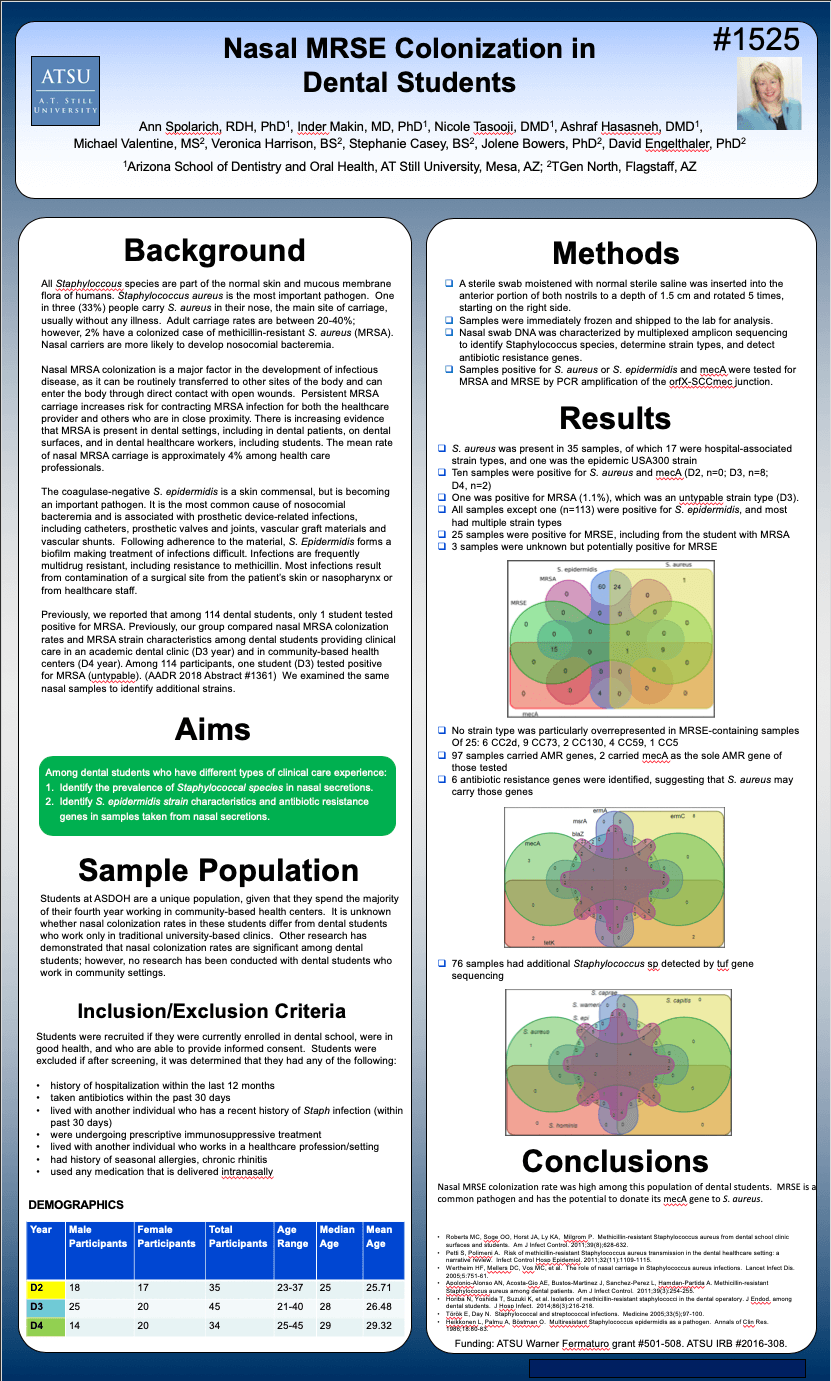Understand nasal MRSE colonization in dental students
Contributors:
Ann Spolarich, RDH, PhD
Inder Makin, MD, PhD
Nicole Tasooji, DMD
Ashraf Hasasneh, DMD
Michael Valentine, MS
Veronica Harrison, BS
Veronica Harrison, BS
Jolene Bowers, PhD
David Engelthaler, PhD
Ann Spolarich, RDH, PhD
Inder Makin, MD, PhD
Nicole Tasooji, DMD
Ashraf Hasasneh, DMD
Michael Valentine, MS
Veronica Harrison, BS
Veronica Harrison, BS
Jolene Bowers, PhD
David Engelthaler, PhD
Participating Organizations:
Arizona School of Dentistry and Oral Health
2TGen North
Arizona School of Dentistry and Oral Health
2TGen North
Background
All Staphyloccous species are part of the normal skin and mucous membrane flora of humans. Staphylococcus aureus is the most important pathogen. One in three (33%) people carry S. aureus in their nose, the main site of carriage, usually without any illness. Adult carriage rates are between 20-40%; however, 2% have a colonized case of methicillin-resistant S. aureus (MRSA). Nasal carriers are more likely to develop nosocomial bacteremia. Nasal MRSA colonization is a major factor in the development of infectious disease, as it can be routinely transferred to other sites of the body and can enter the body through direct contact with open wounds. Persistent MRSA carriage increases risk for contracting MRSA infection for both the healthcare provider and others who are in close proximity. There is increasing evidence that MRSA is present in dental settings, including in dental patients, on dental surfaces, and in dental healthcare workers, including students. The mean rate of nasal MRSA carriage is approximately 4% among health care professionals. The coagulase-negative S. epidermidis is a skin commensal, but is becoming an important pathogen. It is the most common cause of nosocomial bacteremia and is associated with prosthetic device-related infections, including catheters, prosthetic valves and joints, vascular graft materials and vascular shunts. Following adherence to the material, S. Epidermidis forms a biofilm making treatment of infections difficult. Infections are frequently multidrug resistant, including resistance to methicillin. Most infections result from contamination of a surgical site from the patient’s skin or nasopharynx or from healthcare staff. Previously, we reported that among 114 dental students, only 1 student tested positive for MRSA. Previously, our group compared nasal MRSA colonization rates and MRSA strain characteristics among dental students providing clinical care in an academic dental clinic (D3 year) and in community-based health centers (D4 year). Among 114 participants, one student (D3) tested positive for MRSA (untypable). (AADR 2018 Abstract #1361) We examined the same nasal samples to identify additional strains.
All Staphyloccous species are part of the normal skin and mucous membrane flora of humans. Staphylococcus aureus is the most important pathogen. One in three (33%) people carry S. aureus in their nose, the main site of carriage, usually without any illness. Adult carriage rates are between 20-40%; however, 2% have a colonized case of methicillin-resistant S. aureus (MRSA). Nasal carriers are more likely to develop nosocomial bacteremia. Nasal MRSA colonization is a major factor in the development of infectious disease, as it can be routinely transferred to other sites of the body and can enter the body through direct contact with open wounds. Persistent MRSA carriage increases risk for contracting MRSA infection for both the healthcare provider and others who are in close proximity. There is increasing evidence that MRSA is present in dental settings, including in dental patients, on dental surfaces, and in dental healthcare workers, including students. The mean rate of nasal MRSA carriage is approximately 4% among health care professionals. The coagulase-negative S. epidermidis is a skin commensal, but is becoming an important pathogen. It is the most common cause of nosocomial bacteremia and is associated with prosthetic device-related infections, including catheters, prosthetic valves and joints, vascular graft materials and vascular shunts. Following adherence to the material, S. Epidermidis forms a biofilm making treatment of infections difficult. Infections are frequently multidrug resistant, including resistance to methicillin. Most infections result from contamination of a surgical site from the patient’s skin or nasopharynx or from healthcare staff. Previously, we reported that among 114 dental students, only 1 student tested positive for MRSA. Previously, our group compared nasal MRSA colonization rates and MRSA strain characteristics among dental students providing clinical care in an academic dental clinic (D3 year) and in community-based health centers (D4 year). Among 114 participants, one student (D3) tested positive for MRSA (untypable). (AADR 2018 Abstract #1361) We examined the same nasal samples to identify additional strains.
Conclusions
Nasal MRSE colonization rate was high among this population of dental students. MRSE is a common pathogen and has the potential to donate its mecA gene to S. aureus.
Nasal MRSE colonization rate was high among this population of dental students. MRSE is a common pathogen and has the potential to donate its mecA gene to S. aureus.
